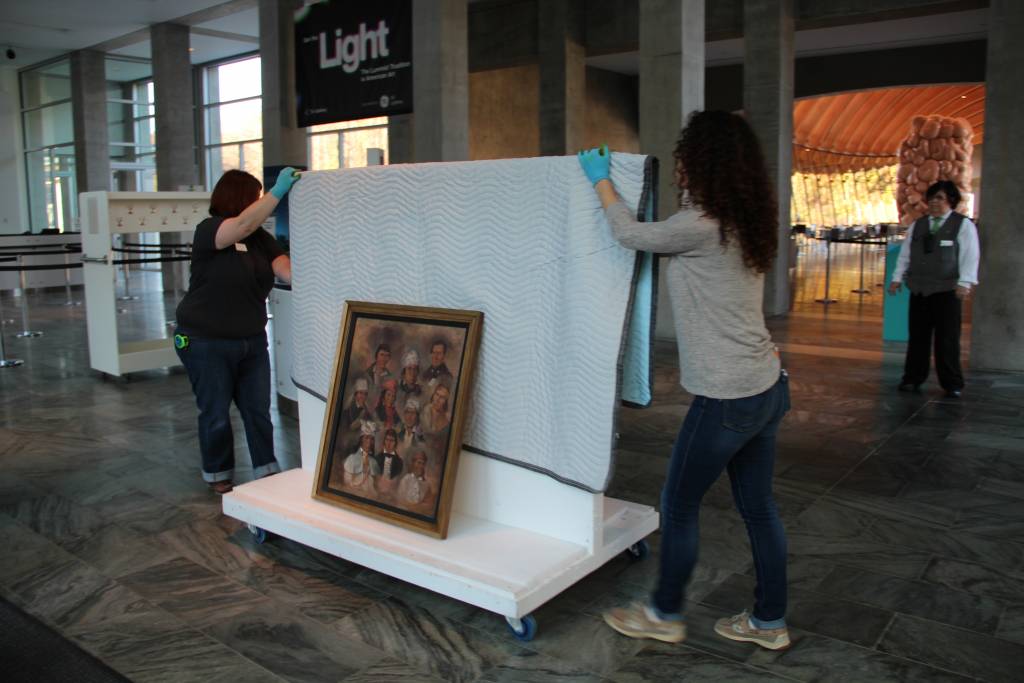11:30 a.m. Site Selection for Sculpture
Before any large-scale sculpture is installed, preparators and curators work together to choose a site for it. First, preparators build a three-dimensional scale model of the work in cardboard so curators can get an accurate idea of how the sculpture will look in place. The cardboard model is much easier and safer to move around than a sculpture that could weigh thousands of pounds!

Preparators installing Robert Indiana’s “LOVE” on the Museum grounds.
When the curator and preparators have decided on a site, preparators mark the exact location for later installation of the work. This may require pouring of a concrete base, installing steel anchors, bringing in a crane to lower the work into place, and/or assembling the sculpture onsite: perhaps welding pieces that had been cut apart for transport. Depending on the size and complexity of the work, the installation may require anywhere from two or three preparators (like Robert Indiana’s LOVE on the South Lawn), or an entire crew, plus facilities and grounds staff, crane operators, welders, and more (as were needed for the complicated installation of Louise Bourgeois’s Maman in the Museum’s courtyard).
3:00 p.m. Receiving New Artwork
Crystal Bridges’ permanent collection is always growing. In 2015, the Museum acquired 511 new artworks, including prints on paper, paintings, mixed media works, and sculpture.
 When the Museum receives new acquisitions or loaned objects for exhibition, their arrival is pre-scheduled through the Collections Department and the Receiving Officer at the loading dock. Upon the arrival of any truck carrying artwork, the dock area is closed to all staff except security, the preparators, and the Museum Registrar. Preparators unload the artwork in its crate and transport it to the vault where it will rest and acclimate for 24 hours before it is uncrated and inspected by the Registrar, who prepares a full condition report on every new artwork.
When the Museum receives new acquisitions or loaned objects for exhibition, their arrival is pre-scheduled through the Collections Department and the Receiving Officer at the loading dock. Upon the arrival of any truck carrying artwork, the dock area is closed to all staff except security, the preparators, and the Museum Registrar. Preparators unload the artwork in its crate and transport it to the vault where it will rest and acclimate for 24 hours before it is uncrated and inspected by the Registrar, who prepares a full condition report on every new artwork.
After the inspection, and before installation in the galleries, Preparators hang incoming paintings on large racks in the vault. Sculptures may remain in their crates to protect them until they are installed.
4:00 p.m. Reframing Works
Sometimes artworks in the collection are removed from their frames and placed in new ones: perhaps because the new frame is more attractive, suits the time period and style of the work better, or because the original frame needs conservation. Artworks are also removed from frames in order to be photographed by a professional photographer. One or more preparators gently remove an artwork from its old frame and reframe it in the new one, or hang the work up in the vault to await conservation or photography.
And More! Temporary Exhibition Installation

Crated artwork for a traveling temporary exhibition.
When a temporary exhibition comes in, it’s “all hands on deck” for preparators, who work with the Museum registrars, curators, and exhibition designers, as well as with visiting preparators from the museum organizing the exhibition. Together they unpack, inspect, arrange, install, and label the works in the exhibition. This is a process that takes several long days, and during this time, access to the temporary exhibition gallery is restricted to only those individuals who are handling the work or directly involved with the exhibition.

Chuck Flook, Crystal Bridges Lead Preparator
Want to see the preparators at work? On Monday, April 25, our Lead Preparator, Chuck Flook, will be taking over Crystal Bridges’ Snapchat! Follow along as Chuck and his team begin installation of new artworks on the Museum grounds!




